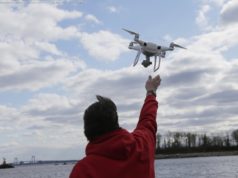For the first time, Navy ROTC students have participated in the academy’s unique, decades-old Yard Patrol training program, designed to make students put their classroom navigation knowledge to use at sea.
ANNAPOLIS, Md. — Lt. Devan Gurecki remembers feeling uneasy the first time she set foot on the bridge of a Navy ship. All she knew about warships she had learned in officer candidate school classrooms. Suddenly, she was a lookout on the bridge and giving directions.
“I literally walked on board my ship the first day, and they threw me on the bridge, and I was like, ‘wait, really? There’s no qualification except for my ensign bars? This is it?’ And I had never done it before, and it was kind of scary because it is a big responsibility,” she said.
Now, as an instructor for the U. S. Naval Academy’s Yard Patrol program, she’s glad to see the military college host about 80 future naval officers from Navy ROTC. The training is designed to make students put their classroom navigation knowledge to use at sea. It’s the first time NROTC students have participated in the academy’s unique, decades-old training program.
Interest in the Yard Patrol program, abbreviated YP, has increased as the Navy explores how to prevent collisions at sea like the ones last year in the Pacific that led to the deaths of 17 sailors in separate incidents involving the USS Fitzgerald and the USS John S. McCain, which is named for the late senator, his father and grandfather. The college has reviewed its seamanship-and-navigation-training curriculum, including the YP program, as part of a larger Navy review. Vice Adm. Ted Carter, the academy’s superintendent, told the academy’s board that the motor skills midshipmen learn in the ships, known as YPs, are valuable.
“If we can get the other community to get even a basic touchstone of some YP time, it will make a difference,” Carter, referring to NROTC, told the board, which includes members of Congress and is similar to a board of trustees at a civilian college.
The newest vessels in the YP class are 119 feet long and about 27 feet wide. Slow and lumbering in the water, they’re rated for about 12 knots, or about 14 mph. They resemble oceangoing research vessels with about a 30-person crew. The vessels have comparable equipment used on Navy ships, including electronic navigation and automatic radar plotting aids.
In addition to training trips into the nearby Chesapeake Bay, they take trips at sea for about two and a half weeks during summer up the East Coast, including stops in Baltimore, Philadelphia, New York and Newport, Rhode Island, or Boston.
Lt. Carlton Smith, who graduated from the academy in 2012 and is now a YP trainer, said the program enables students to start building muscle memory needed to drive ships.
“While it’s not 100 percent identical to what to expect on a warship, it’s still extremely close,” Smith said.
The YP program teaches students basic “rules of the road” at sea and how to maneuver around other ships. Students also stand watch, conduct drills and learn about the routine of being aboard. Students work as a team to navigate the ship, plotting positions and communicating with other vessels in the area. They also work on adjusting for mechanical problems.
Colin Welborn, an ROTC student at Virginia Tech, participated in one of the training trips this summer. He said the training was valuable, because students get firsthand experience, instead of simply observing other people.
“Here, we are the bridge. We are the pilot house, and so we are being treated right now as we’re junior officers,” Welborn said as the ship cruised in the Chesapeake Bay. “Even though we’re being guided, there’s oversight, we are the functioning team on a ship, so it’s a whole different domain.”
Cmdr. Chad Graham, chairman of the academy’s seamanship-and-navigation department, said the academy plans to host another 80 NROTC students next summer. He also said the program could be expanded to accommodate more students in the future if the Navy makes the investment. That would enable the academy to bring in double to triple the number of NROTC students who came to Annapolis this year and could cover all of NROTC’s surface warfare candidates, Graham said.
Commissioned Navy officers come from three main sources: the academy, Navy ROTC programs and officer candidate school. The academy commissioned about 1,073 officers last year, the academy said. Navy ROTC commissioned 1,049 officers, and officer candidate school commissioned 1,103, according to Naval Service Training Command.
While newly commissioned Navy officers get training elsewhere, it’s either by simulation or on an actual ship, Graham said. The academy’s YPs are the only training-craft program in the Navy. Every midshipman at the academy gets at least some YP training. Students who decide to enter surface warfare receive added training.
While simulators are effective teaching tools, Graham said they just aren’t the real thing.
“I’m just in a position where I have the luxury of having these Yard Patrol craft, and I know there’s a lot more feedback that comes from hearing that anchor scrape along the seawall and where your positioning is, compared to being in the trainer in here and the fake noise coming out of the simulator,” Graham said.






